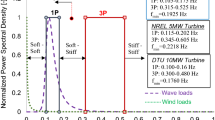Abstract
The loads induced as a result of seismic activities may jeopardize the serviceability of offshore wind turbines or may even lead the structure to reach the ultimate strength. The maximum load-carrying capacity of a support structure can be estimated by performing a structural assessment which accounts for the nonlinear effects arising from the material and geometry. The present work aims to analyze the fragility of a 5 MW monopile offshore wind turbine structure subjected to seismic activities accounting for soil interactions and time-variant structural degradation. The offshore wind turbine structure is subjected to different ground motions with different intensity. The nonlinear full transient dynamic structural analysis is carried out based on the finite element method, and the nonlinear monopile structural response during the different seismic activities is discussed. Finally, the fragility curves associated with the serviceability limit state design and the ultimate strength limit state are developed.















Similar content being viewed by others
References
Ajamy A, Asgarian B, Ventura CE, Zolfaghari MR (2018) Seismic fragility analysis of jacket type offshore platforms considering soil-pile-structure interaction. Eng Struct 174:198–211
Alam J, Kim D, Choi B (2017) Uncertainty reduction of seismic fragility of intake tower using Bayesian Inference and Markov Chain Monte Carlo simulation. Struct Eng Mech 63:47–53
ANSYS (2009) Advanced Analysis Techniques Guide vol Release 12.1. Ansys, Inc, Southpointe, 275 Technology Drive,Canonsburg, PA 15317
Asareh M-A, Schonberg W, Volz J (2016) Fragility analysis of a 5-MW NREL wind turbine considering aero-elastic and seismic interaction using finite element method. Finite Elem Anal Des 120:57–67
British Standard (2005) Eurocode 8: design of structures for earthquake resistance, part 1 - general rules, seismic actions and rules for buildings, BS EN1998-1:2004. British Standard, Brussels
De Risi R, Bhattacharya S, Goda K (2018) Seismic performance assessment of monopile-supported offshore wind turbines using unscaled natural earthquake records. Soil Dyn Earthq Eng 109:154–172
Elnashai AS, Di Sarno L (2008) Fundamentals of earthquake engineering. Wiley, New York
Garbatov Y, Guedes Soares C (2008) Corrosion wastage modeling of deteriorated bulk carrier decks. Int Shipbuild Prog 55:109–125
Garbatov Y, Guedes Soares C, Wang G (2007) Nonlinear time dependent corrosion wastage of deck plates of ballast and cargo tanks of tankers. J Offshore Mech Arc Eng 129:48–55
Golafshani AA, Ebrahimian H, Bagheri V, Holmas T (2011) Assessment of offshore platforms under extreme waves by probabilistic incremental wave analysis. J Constr Steel Res 67:759–769
Hallowell ST et al (2018) Hurricane risk assessment of offshore wind turbines. Renew Energy 125:234–249
Han J, Moraga C (1995) The influence of the sigmoid function parameters on the speed of backpropagation learning. In: Mira J, Sandoval F (eds) From natural to artificial neural computation. Lecture notes in computer science. Springer, Heidelberg , pp 195–201
Ioannou I, Douglas J, Rossetto T (2015) Assessing the impact of ground-motion variability and uncertainty on empirical fragility curves. Soil Dyn Earthq Eng 69:83–92
Kennedy RP, Cornell CA, Campbell RD, Kaplan S, Perla HF (1980) Probabilistic seismic safety study of an existing nuclear power plant. Nucl Eng Des 59:315–338
Kim DH, Lee SG, Lee IK (2014) Seismic fragility analysis of 5 MW offshore wind turbine. Renew Energy 65:250–256
Martins L, Silva V, Bazzurro P, Marques M (2018) Advances in the derivation of fragility functions for the development of risk-targeted hazard maps. Eng Struct 173:669–680
Mo R, Kang H, Li M, Zhao X (2017) Seismic fragility analysis of monopile offshore wind turbines under different operational conditions. Energies 10:1037–1059
Reese LC (1983) Behavior of pile groups under lateral loading. U.S. Department of Transportation, Federal Highway Administration, Washington, D.C
Rossetto T, Ioannou I (2018) Empirical fragility and vulnerability assessment: not just a regression. In: Michel G (ed) Risk modeling for hazards and disasters. Elsevier, Amsterdam, pp 79–103
Rota M, Penna A, Magenes G (2010) A methodology for deriving analytical fragility curves for masonry buildings based on stochastic nonlinear analyses. Eng Struct 32:1312–1323
Saad-Eldeen S, Garbatov Y, Guedes Soares C (2011) Experimental assessment of the ultimate strength of a box girder subjected to severe corrosion. Mar Struct 24:338–357
Shinozuka M, Feng MQ, Kim H-K, Kim S-H (2000) Nonlinear static procedure for fragility curve development. J Eng Mech 126:1287–1295
Silva JE, Garbatov Y, Guedes Soares C (2013) Ultimate strength assessment of rectangular steel plates subjected to a random non-uniform corrosion degradation. Eng Struct 52:295–305
Solomos G, Pinto A, Dimova S (2008) A review of the seismic hazard zonation in national building codes in the context of eurocode 8 JRC-Scientific and Technical Reports—EUR 23563:72
Yeter B, Garbatov Y, Guedes Soares C (2017) Risk-based multi-objective optimisation of a monopile offshore wind turbine support structure, OMAE2017–61756. In: Proceedings of The 36th International Conference on Ocean, Offshore and Arctic Engineering, OMAE17, Trondheim, Norway, June 25–30 2017
Yeter B, Garbatov Y, Guedes Soares C (2019) Uncertainty analysis of soil-pile interactions of monopile offshore wind turbine support structures. Appl Ocean Res 82:74–88
Zeinoddini M, Namin YY, Nikoo HM, Estekanchi H, Kimiaei M (2018) An EWA framework for the probabilistic-based structural integrity assessment of offshore platforms. Mar Struct 59:60–79
Zentner I, Gündel M, Bonfils N (2017) Fragility analysis methods: Review of existing approaches and application. Nucl Eng Des 323:245–258
Zheng XY, Li H, Rong W, Li W (2015) Joint earthquake and wave action on the monopile wind turbine foundation: An experimental study. Mar Struct 44:125–141
Acknowledgements
This work was performed within the Strategic Research Plan of the Centre for Marine Technology and Ocean Engineering (CENTEC), which is financed by Portuguese Foundation for Science and Technology (Fundação para a Ciência e Tecnologia - FCT) under contract UID/Multi/00134/2013-LISBOA-01-0145-FEDER-007629.
Author information
Authors and Affiliations
Corresponding author
Rights and permissions
About this article
Cite this article
Yeter, B., Tekgoz, M., Garbatov, Y. et al. Fragility analysis of an ageing monopile offshore wind turbine subjected to simultaneous wind and seismic load. Saf. Extreme Environ. 2, 155–170 (2020). https://doi.org/10.1007/s42797-020-00015-9
Received:
Revised:
Accepted:
Published:
Issue Date:
DOI: https://doi.org/10.1007/s42797-020-00015-9




